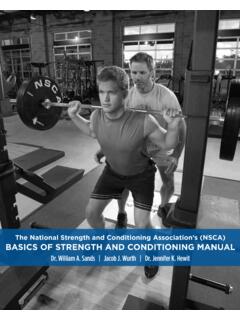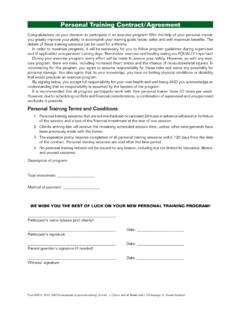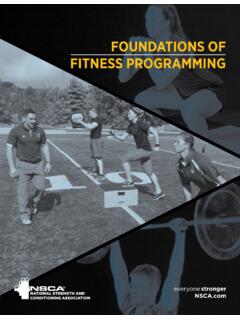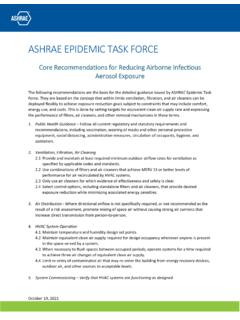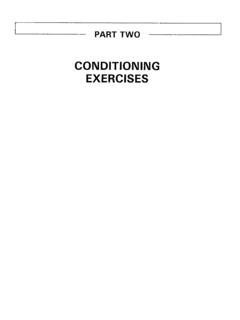Transcription of The National Strength and Conditioning Association’s (NSCA ...
1 The National Strength and Conditioning Association's (NSCA). BASICS OF Strength AND Conditioning MANUAL. Dr. William A. Sands | Jacob J. Wurth | Dr. Jennifer K. Hewit Table of Contents Chapter 1 | Introduction 7 Lifting a Bar from the Floor 29. What is Expertise? 8 Spotting 29. Increase Safety Awareness 8 Types of Exercises that Require Spotting 29. Develop Your Abilities to Supervise Strength Training and Spotting Overhead Exercises 29. Conditioning Activities 8 Spotting Over-the-Face Exercises 29. An Overview of Strength Training and Conditioning 8 Spotting Considerations for Power Exercises 29.
2 Principles of Training 9 Number of Spotters 29. Overview of Energy Systems 10 Communication Between Athlete and Spotter 29. Conclusion 10 Amount and Timing of Spotting Assistance 30. Spotting Techniques 30. Chapter 2 | Program Design 13 Barbell Bench Press - Spotting Technique 30. How Do We Organize Training? 14 Dumbell Incline Bench Press - Spotting Technique 31. Training Design Terminology 14 Barbell Standing Behind the Neck Shoulder Press - Specific Adaptations to Imposed Demands Spotting Technique 31. (SAID Principle) 14 Barbell Back Squat - Spotting Technique Annual Plan 14 with One Spotter 32.
3 Macrocycle 14 Barbell Back Squat - Spotting Technique with Three Spotters 33. Mesocycle 14. Microcycle 14. Training Lesson 14. Chapter 4 | Exercise Technique 35. Explosive Lifting Day Outline 36. Program 14. Strength Lifting Day Outline 36. Basics of Program Design Decisions 14. Explosive Lifting Day Exercise Technique 36. Training Load Prescriptions 15. 1. Clean Progression 36. Rules for Exercise Selection and Prescription 15. 1a. Barbell Rack Clean 36. Warm-Up and Stretching 15. 1b. Barbell Hang Clean 37. Components of a Warm-Up 16. 1c. Barbell Power Clean 38.
4 Stretching During Warm-Up 17. 2. Barbell High Pull 40. Conclusion 17. 2a. High Pull from the Hang 40. Sample Strength and Conditioning 12-Week Program 19. 3. Shoulder Progression 41. 3a. Dumbbell Shoulder Raises 41. Chapter 3 | Technique Fundamentals and Spotting 27 3b. Barbell Standing Behind the Neck Technique Fundamentals 28 Shoulder Press 42. Handgrips 28 3c. Barbell Push Press 42. Grip Width 28 3d. Barbell Push Jerk 43. Stable Body and Limb Positioning 28 4. Pulling Choice 44. Range of Motion and Speed 28 4a. Pull-Ups 44. Breathing Considerations 29 4b. Standing Low Row 44.
5 Basics of Strength and Conditioning 1. 4c. Lat Pulldown 45 Anthropometric Factors 64. 4d. Bent-Over Row 45 Agility Training Drills and Programming 64. 5. Biceps Choice 46 Warm-up Drills 66. 5a. EZ-Bar Curl 46 1. High-Knees - 10 yards down and back 66. 6. Abdominals Choice 46 2. Heel-Ups 10 yards down and back 66. 6a. Hand Planks 46 3. Forward Lunge with Elbow to Instep 10 yards 66. 6b. Elbow Planks (front and sides) 47 4. Side Lunge with Squat 4 each side 66. Strength Lifting Day Exercise Description 48 5. High Knee Foreleg Extension 10 yards down slow, 1. Leg Progression 48 10 yards back quick 67.
6 1a. Barbell Back Squat 48 Speed Drills 68. 1b. Barbell Front Squat 50 1. Build-Ups 40 yards 68. 1c. Barbell Clean Deadlift 51 2. Form Starts 68. 2. Barbell Romanian Deadlift 52 3. Position Starts 68. 3. Single-Leg Choice 52 4. Flying 10s 69. 3a. Forward Step Lunge 52 5. Power Skips (for height) 69. 3b. Walking Lunge 52 6. Power Skips (for distance) 69. 4. Pushing Progression 53 7. Flying 20s 70. 4a. Barbell Bench Press 53 8. Harness Routine 70. 4b. Barbell Incline Bench Press 54 9. Flying 30s 70. 4c. Dumbbell Bench Press 54 10. Bag Jumps 71. 4d. Dumbbell Incline Bench Press 55 11.
7 Hollow Sprints 71. 5. Triceps Choice 55 Agility Drills 71. 5a. Triceps Pushdown 55 1. Rope or Ladder Routine 71. 6. Abdominals Choice 56 1a. Every Hole 71. 6a. Heel Touches 56 1b. Every Other Hole 72. Conclusion 56 1c. Lateral Step 72. 2. Bag Routine 72. 2a. Change of Direction 72. Chapter 5 | Speed and Agility Training 59. 2b. Shuffle 72. Introducing Plyometrics 60. 2c. Forward and Backpedal 73. Plyometrics 60. 3. Line Jump Routine 73. The Stretch-Shortening Cycle 60. 3a. Single Bunny Hop 73. Deceleration and Jump Training for Novice Athletes 61. 3b. Double Bunny Hop 73.
8 Speed and Agility 61. 3c. Scissors 74. Linear Speed 61. 3d. Ali Shuffle 74. Agility 62. 4. Pro-Agility 74. Interval Training 62. 5. Nebraska Agility 74. Components of Agility 62. 6. Three-Cone Drill 75. Perceptual Decision-Making Factors 62. 7. Four-Corner Drill 75. Technical Factors 62. 8. Sprint Ladder 76. Physical Factors 64. 2 Basics of Strength and Conditioning 9. Shuffle Ladder 76. 10. Backpedal Ladder 77. Landing Drills 77. 1. Drop Jump 77. 2. Vertical Jump 78. 3. Tuck Jump 78. 4. 180 Degree Jump 78. 5. Broad Jump with Vertical Jump 79. 6. Depth Jump 80. 7.
9 Box Shuffle Step 80. 8. Double Box Shuffle Step 80. 9. Lateral Box Jump 81. Sample Program for Agility Drills - Weeks 5-12 85. Sample Program for Speed Drills - Weeks 7-12 89. Chapter 6 | Safe Training 93. Waivers and Informed Consent 94. Pre-Participation Screening and Clearance 94. Warnings 94. Supervision 95. Facility 96. Performance Safety Team 97. Preventing Sudden Death 97. Special Considerations 97. Sickle Cell Trait 97. Sudden Cardiac Death 98. Concussion 98. Exertional Rhabdomyolysis 98. Hyperthermia 99. Copyright 2012 by the National Strength and Conditioning Association.
10 All rights reserved. Basics of Strength and Conditioning 3. Performance Pyramid 4 Basics of Strength and Conditioning Letter From the Founder Dear NSCA Member: The National Strength and Conditioning Association (NSCA) is excited to provide you with this Basics of Strength and Conditioning Manual. This manual is intended to assist Associate Members, however, it is available to all NSCA Members to help them learn the basic principles and movement fundamentals that should be included in every Strength and Conditioning program. The first three levels of the Performance Pyramid covered in the Basics of Strength and Conditioning Manual will help prepare you to monitor or supervise Strength and Conditioning workouts.




